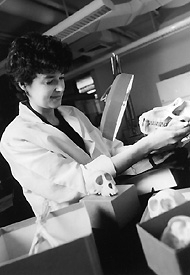![]()
Departments
![]()

|
Week of 24 September 1999 |
Vol. III, No. 7 |
Feature
Article
Anthropology evolves at BU
By Hope Green
Why do Homo sapiens walk upright instead of knuckles to the ground? Can one's choice of mate be explained scientifically? How did the brain and language evolve together?
To an increasing extent, undergraduates at Boston University are examining such enigmas of human behavior in depth. Making their explorations possible is a program launched last fall in biological anthropology, an approach to studying our species within an evolutionary context while drawing on disciplines as diverse as paleontology, anatomy, and nutrition.
|
|
|
Laura MacLatchy, a CAS assistant
professor of anthropology, peers through a lighted
magnifying lens at a baboon skull. She is one of
three biological anthropologists on BU's faculty.
Photo by BU Photo
Services
|
BU already has a strong sociocultural anthropology program, but in recent years the department has recognized a growing interest in anthropology among undergraduates who are planning careers in medicine and public health. The trend occurs at a time when biological science programs around the country are zooming in on molecular processes while de-emphasizing the study of whole organisms.
"A lot of students interested in the life sciences see biological anthropology as an attractive alternative to a concentration in regular biology," says CAS Assistant Professor Laura MacLatchy, "because it gives them greater opportunities to focus on humans at an early stage in their careers."
BU has welcomed three biological anthropologists to the faculty in the last seven years. The pioneer was Terrence Deacon, a CAS associate professor, neuroscientist, and author of The Symbolic Species, a critically acclaimed book about the origins of human language capability. He was hired in 1992 and joined by MacLatchy and Assistant Professor Benjamin Campbell two years ago.
Campbell's research focuses on male reproductive biology, while MacLatchy studies primate posture and locomotor adaptations, the evolution of various bone structures in apes and humans that enable them to move about. The professors' field work often stimulates classroom discussions, as does a new collection of artifacts the department recently purchased.
"We have important casts and fossils from Kenya and South Africa that students can handle, rather than just look at in a book," MacLatchy says. "They can observe up close some of the features scientists have talked about, such as how brain size or tooth size decreased over time."
Last year 15 students received degrees with a biological anthropology concentration. Another 20 are currently enrolled, and a graduate program in the field is scheduled to launch in fall 2000. Amy Kroeplin (CAS'99), who completed the course track last spring, says she appreciated the hands-on lab work, as well as a chance to conduct an independent study on ape shoulder structure under MacLatchy's supervision. In other elective projects, seniors have spent time at the Franklin Park Zoo in Boston observing gorilla hand function or working with Campbell to analyze disease patterns among the Turkana nomads of Kenya.
"The program is really ideal for students with an interest in biology, but who are more specifically interested in humans, primates, or evolution," Kroeplin says.
